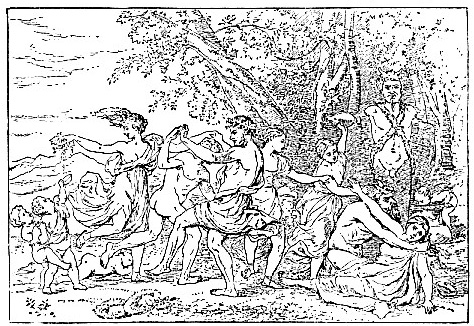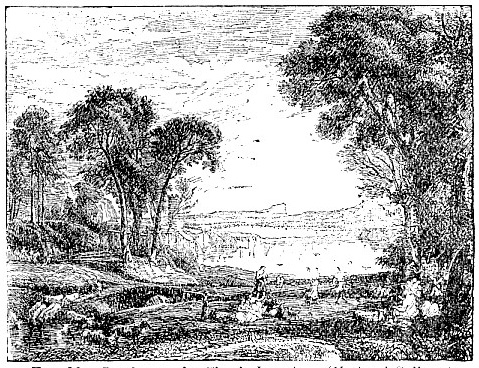1902 Encyclopedia > Schools of Painting > French School of Painting
Schools of Painting
(Part 13)
French School of Painting
French art, like that of Spain, was almost wholly under Italian influence during the 15th and 16th centuries.
Nicolas Poussin, in the 17th century, was the first to develop a native style, though he was much influenced by Titian. His best works are bacchanalian scenes, of which one of the finest is in the National Gallery (see fig. 38). When at his best his flesh painting resembles that of Titian, but it is frequently marred by unpleasant hot coloring.

Fig. 38 -- Bacchanalian Scene, by Nicolas Poussin. (National Gallery.)
Claude Lorrain is remarkable for his beautiful and imaginative landscape,-- often wanting in a real study of nature (see fig. 39). His finest works are in England (see p. 445).

Fig. 39 -- Landscape, by Claude Lorrain. (National Gallery.)
Throughout the 18th century the French school was very prolific, but shared the mediocrity of the age, the corruption and artificiality of which impressed themselves strongly on the painting of the time. The most popular artists of that century were Watteau, Boucher, Greuze, Claude Vernet, Fragonard, and David, the reviver of the pseudo-classic style.
In the first half of the 19th century Prud'hon, Ingres, Horace Vernet, and Delaroche -- artists of only moderate merit -- were in great repute, and more deservedly the very brilliant landscape painter Rousseau. Millet, though, little valued during his lifetime, is now highly appreciated. Regnault, a very able painter, who while yet young was killed at the siege of Paris in 1871, belongs to the latest development of French art.
At present (1886) Paris possesses by far the most important school of art existing, and French painters on the whole are supreme in power of drawing and in technical skill. Unhappily these great merits are often counter-balanced by false sentimentalism or excessive realism, and especially by gross sensuality.
Art in France -- that is, in Paris -- is now in a state of the most prolific activity, and is branching out into new and startling phases, such as the impressionist style, in which form is suppressed for the sake of colour, and the naturalist school, which leans rather to what is ugly or even loathsome; to the latter belong some of the technical ablest painters alive. (Footnote 441-1)
As in Spain and Italy, the influence of Fortuny is strong in Paris, and Parisian influence now extends very widely, as the Ecole des Beaux-Arts is resorted to by art students from all countries except Germany.
Footnote
441-1 A few years ago a gold medal was won at the Salon by a picture of this class, -- a real masterpiece of technical skill. It represented Job as an emaciated old man covered with ulcers, carefully studied in the Paris hospitals for skin diseases.
Read the rest of this article:
Schools of Painting - Table of Contents
|

